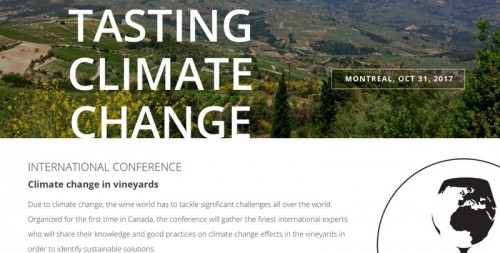
Yesterday was the Tasting Climate Change conference https://www.tastingclimatechange.com/en/ , organized by Michelle Bouffard and held in Montréal, Canada. It was a half-day event looking at the impact of climate change on wine.
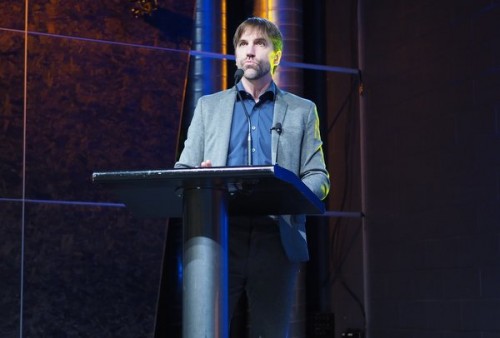
Stephen Guilbeaut, CEO of Équiterre, began by presenting an overview of the situation globally. CO2 concentrations are currently highest than they’ve been for 800 000 years, and this rise is through human activity. The trends are very clear: our planet is getting warmer and warmer.
So what are the implications if the planet warms by 3 C in the coming years? This is the projection by scientists of the sort of scale of change likely over the next century. This level of change would likely have dramatic impacts on the life on planet. Let’s remember that when Canada was completely covered in ice, the average temperatures were only 4C cooler. He pointed out that 1976 was the last time that average global temperatures were below average.
Risks include increasing drought, especially closer to the equator. But they also concern wine regions: in Napa, the severe droughts have meant that if you look at the fire hazard severity map, there are lots of areas with a huge risk. Such severe droughts in California have resulted in legislation to cut water use by 35%. Overall, globally there has been a severe increase in the cost of natural disasters.
Fortunately, people have started paying attention to this problem. Steven described how he recently attended the Paris Agreement, where there were three rooms meeting simultaneously each with 5000. The world is starting to recognize the severity of the situation.
How bad are things? Current policies take us +3.6 C in the next 100 years. If pledges made in Paris are kept, then temperatures should rise by +2.7 C. It’s not enough of a change but it is significant. All the modelling shows that if we pass the +2 C mark, the climate will probably get out of hand, so this is a good first step but we need to do more.
What’s happening? There have been investments in renewable energy production, that since 2010 have surpassed those in fossil fuel. And while fossil fuel is still the dominant source of energy, the prospects aren’t good for them (fortunately). As an example, the value of coal companies in the USA was $63 billion in 2011, but this had fallen to $4.7 billion in 2016. Even the Kentucky coal museum is switching to solar power (this is where the coal industry started in the USA).
It might surprise many to hear that China is a solar power giant. They are responsible for 70.5% of the world market of solar energy, and this is in just a decade after they began with it. They are shutting down coal plants and replacing them with renewables.
What about cars? China will force car companies to produce 8% zero emission vehicles if they sell in China, and in Quebec, car companies will need to produce 3% of these. We are witnessing the beginning of the end of the internal combustion engine.
If we are to move away from cars, then we need to change our thinking about how we organize our cities. Pedestrians in modern north American cities have a hard time, because most of these cities developed in the age of the car. The road has to be shared by different users.
The building sector is also going through changes, with more energy efficient designs
We have gone through many technological and social changes over the last 50 years, and responding to climate change will require some more changes. The good news: we already have the tools needed to address these challenges. We just need more willingness to make it happen.
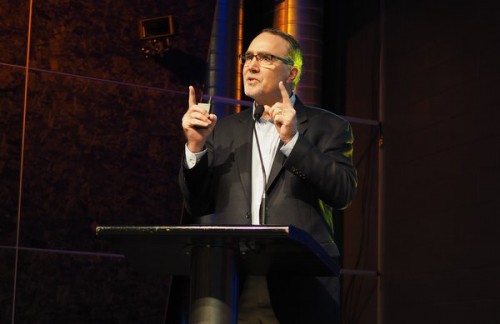
The second speaker, Dr Gregory Jones, is well known for his work on climate change and wine. He began by pointing out that the wine map is changing. China and Russia, for example, are planting more vineyards. There are also a lot of fringe cool climate producers, in latitudes we wouldn’t have dreamed about a few decades ago.
These changes are in response to growing demand and changing demographics, with new markets and styles of wines emerging. There are also new purchasing trends, such as vending machines. There are changes in the tastes of writers and critics. There is a large movement in the production of bulk wine. There is a keen interest in organic and biodynamic production. But most of all, underlying these changes is climate change.
Greg went on to explain that all the grape varieties we know and love have climatic thresholds. Each can only be produced successfully in certain climatic ranges. Pinot Noir, for example is a narrow climate niche variety. You can grow Pinot Noir outside these climatic bounds but it either isn’t economically viable, or the wine isn’t stylistically suitable. He showed the spatial climate envelope for Burgundy: if this is compared with another Pinot Noir region, the Willamette Valley in Oregon, we can see that the envelope for Oregon overlaps that of Burgundy, but is broader. If we look at the envelope for Bordeaux, we can see that it is warmer than that of Burgundy. If we compare Napa with Bordeaux, we see that it is wider, and also warmer. Using these climate envelopes, it’s possible to see the impact of rising average temperatures on the world’s wine regions.
One of the effects of climate change is that the dormant periods have got warmer in many regions, so the same cold hardiness doesn’t develop, yet the winter freezes and extremes are still present. And warmer soil temperatures result in earlier budbreak, but the same frosts still occur. There aren’t dramatic changes in flowering, but cloud cover and rainfall can be more frequent affecting fruit set. Another observation is longer growing seasons and higher heat accumulation, but with high temperature variability. Also, lower diurnal temperature ranges occur during the final stages of ripening.
Greg explained that on average phenology has shown a shift 5-10 days, and the phases between these stages of growth have been compressed too.
There have been climate-related changes in soil fertility and erosion. CO2 levels are higher, but Greg says that there’s not enough research to say anything about this and its impact on viticulture. Other issues are water availability, and altered disease and pest susceptibility.
The +1 C change over the 1950-2000 period has changed the viticultural map. For cool climate wine production, some regions are now too warm whereas others have become suitable that weren’t before.
Looking to the future, Greg used the example of the Willamette Valley in Oregon. A +1 C warming causes the climate envelope to move, and the capability for other varieties increases, while still allowing the region to grow Pinot and Chardonnay. But a 2 C rise pushes the envelope completely out of the spectrum of what can be grown today.
Continued warming of the world’s wine regions is highly likely: the next century will see 1.5-4.5 C warming. If this was a straightforward rise in average temperatures, then playing to the averages is easier to deal with. But it’s the fact that there are more extremes that makes things much harder. If it was simply a question of rising average temperatures, then planting new varieties or moving to cooler areas would be an answer. But the variability we are likely to experience makes confronting change much trickier.
Altered ripening profiles creating challenges in managing timing of acid, sugar and flavour. There are also altered irrigation needs, and altered disease and pest issues.
Greg outlined some ways that the wine world can adapt to changing climates. Wine grapes have a huge genetic pool of potential for adaptation. There’s also the landscape potential – we need to understand where we plant grapes and how we manage the vines. There are alterations to canopy geometry and even the use of shading materials. Scion/rootstock combinations need to be understood better, and we also need a better understanding of grape vine water use efficiency and irrigation management.

As a consultant, Alberto Antonini has had some weird experiences of late. For example, in 2017 the vintage in Australia was the latest and coolest ever, while in Chile it was the earliest ever by a month. In Tuscany, 2017 was the driest and earliest ever, with picking in mid-August. He also mentioned Mendoza, where he’s been working for 22 years. It’s a desert, with 50-100 mm rain a year, but two years ago rainfall was six times more than average. Last year, it was three times the normal. ‘We had no experience of spraying for downy mildew,’ he says. ‘But two years ago we had to spray 12-14 times, when we normally spray 1-3 times.’
All he can do, he says, is make sure the vines are strong, healthy and fit. Healthy vines are much better at dealing with climatic variation, and the key to this is the soil. Soil is the most important part of vineyard management, and is critical for wine quality.
Alberto says that at wine school people are taught the wrong methods of vineyard management, using herbicides. ‘The soil is dead with compaction and no life or biodiversity.’ He showed pictures of a conventional vineyard that he had the task of reviving. The soil pit showed compaction, with no air or water going through, no biomass, and no microbiology. The root system is superficial in this compacted soil, and the roots are big. ‘Superficial roots are the worst because they live in the least interesting part of the soil, and they can’t go deep because of compaction,’ he says. And drip irrigation spoils the root system by encouraging the superficial roots.
In this Tuscan farm he started regenerating the soil in 2012, removing compaction by deep ripping, developing cover crops generating some biomass. After 3 years of this, the soils were totally transformed, with more porosity, more fine roots, and the root system has gone down deeper.
At university they were taught to use synthetic chemicals. ‘With the arrival of all these miracle chemicals we have lost the relationship with the soils, plants and climate,’ says Alberto. ‘The farmers have lost the wisdom they had 70 years ago.’ He points out that what we now call organic or biodynamic farming is nothing new: it’s how things used to be done. ‘To me, the major problem is not to regenerate the soil (this is quite fast)’ says Alberto. ‘The problems is farmers have lost wisdom that will take many decades to rediscover. This is a major concern.Lots of young people are committed to doing the right things, but they just don’t have experience.’ He adds: ‘We need wise experienced red necks, not oriental gurus.’
The answer to climate change isn’t straightforward, but one way forward is to plant sensible varieties and manage vineyards properly. ‘In Sicily this year there was a big drought, but the vineyards that survived best were planted with local varieties, not the international varieties that the market had forced on growers. The local grapes performed well. Part of the solution is there already: stay focused on what was there already.’
The best performing vineyards were those planted on the traditional 140R rootstock. These did much better than more vigorous rootsocks, and drip irrigated vineyards did poorly. ‘In Europe, we need to stay focused on the local grapes.’
‘Irrigation is quite an issue these days,’ says Alberto. ‘In some circumstances it is needed, such as in Mendoza. But I don’t think it is the answer. It is like an addiction: the vines just need more. Try hard first to see what people have done in warm regions. Have fewer vines per hectare and try other techniques that allow them to dry grow.’
‘Study botany, plant physiology, microbiology and soil science. Not viticulture and enology. Understand how mother nature works.’
‘In the new world the scenario is different. It’s important to identify the best grapes. The new world has developed grapes because they were asked by the market. But it is important review this and focus on developing what is really doing well in every wine region.’
‘Don’t make the wine for the market but find the market for what you do.’
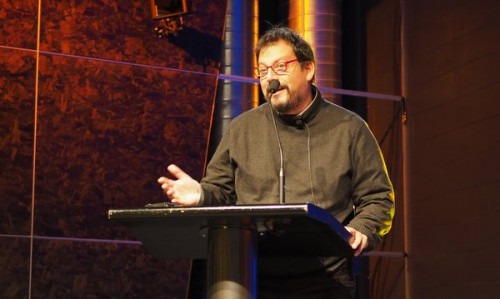
The next speaker was Pedro Parra, who was entertaining and quite controversial. ‘I wanted to be a musician or a movie director,’ says Pedro, ‘but I ended up with terroir.’ He added, ‘there is no book on terroir. If you want to know what is making Burgundy great, nobody knows.’
‘Terroir is a global concept. You need to be old to have experience,’ says Pedro. He acknowledges that over the years he has changed his understanding, and learned new things. ‘Many clients should be paid back because every year I realise I was wrong.’
He’s not keen on a quantitative approach, and he finds much of the talk about soils meaningless. ‘I don’t want to look at numbers – when you travel and ask people about terroir they might say silty clay – this means nothing. Is is silt from limestone or granite?
What kind of clay? We need way more information to start talking.’
He then outlined the sorts of soils he looks for to make high quality, mineralic wines.
First of all, is the soil stony or not stony? ‘If it’s not stony it will be very boring to me and I will advise people to sell the property!’ he says. Then, for stony soils, is it limestone, granite, schist, gravels or basalt?
There are then a set of key factors in separating good from bad soils.
First, weather. Then stress. ‘This is a major problem today, every year I am seeing more stress.’
Another factor is the ratio of flesh/bone. ‘A good wine has flesh (soil) and bone (stones),’ he says. So there might be 1 m of soils and then stones or 2 m then stones. ‘A very bony place is Priorat, where you might get 200 g grapes per vine. Then you go to other places and they make 2.5 kg/vine.’
Then there is the ratio of alteration (rock is very hard, eg chambolle) to alterite (more fractured, more water holding capacity). The alterite is the bit at the top, over the alteration.
Clay quality is important. Pedro’s PhD was funded by Don Melchor. Their vineyard had stones, silt and clay. The vines struggled. Then over in Mendoza 20 minutes away by plane, there were vineyards with the same soils but the vines were so vigorous. It was the clay was different. 10% montmorillite clay is so much more efficient than 40% of kaolinite clay in terms of storing water and making it available to the vine.
The type of fracture of the rocks is important. Each fracture of limestone means some food for the vine, so the number of layers is important, but there’s no way we can measure this: it is a mystery forever.
The percentage of stones is important, as is drainage and water-holding capacity.
Across the world the superficial part of the soil is largely the same: what matters is what is under it, and this is where the fractures are important. Pedro has been looking deeper down in soils. ‘The results are amazing – we shouldn’t don’t take samples in the superficial soils.’ He says that if the roots are in the superficial soils you will be making MacDonald’s wines.
One of his strategies is to identifying the best parts of vineyards, which he calls polygons, and manage them differently and harvest them separately. He also talked about slopes. In the typical slope, the upper part is too dry and bony, resulting in dry tannins and higher alcohol. The middle is the ‘grand cru’ area. And the bottom bit tends to have better water holding capacity – so this will react better to global warming, and it might be that the village level might be the best wine. He says that these days, in Tuscany the deep clay soils are the best at the moment, with better vigour, no sunburn.
In Burgundy, Chambolle will suffer more than Vosne-Romanee, because it has just 40 cm of soil and then no soil in the underlying rock, just in fractures, and so the wines can end up with dry tannins in warm years.
As to climate change, one easy solution is to change the rootstock, but it will take 50 years. Another solution is to work the soils better, but how do we learn to do this? A recipe doesn’t work. If you have different clay or soil it will need to be worked differently. ‘We agree that working the soil is a great solution but we need to understand soils.’
Irrigation is a dangerous solution, he says. A drip irrigation of 8 h sends water just 40 cm deep, resulting in a superficial root system. He suggests irrigating for longer: a 40 h irrigation might be needed in order to mimic rain. But this all depends on the vineyard. He recalls when he worked in Chile with John Duval, in a warm climate with granite soils. They did just one long irrigation in one season for this reason.
I was the final speaker. I talked about my experience with wine regions worldwide, and which were the winners and losers when it came to climate change, as well as the sorts of challenges that the wine world was facing with rising temperatures and increased variation in weather. But more on that another time.
We finished with a lengthy Q&A session. Overall, it was a great set of speakers and a really good conference. Michelle will be repeating it in two years’ time.
2 Comments on Tasting Climate Change, in Montréal: the impact of warming on wine
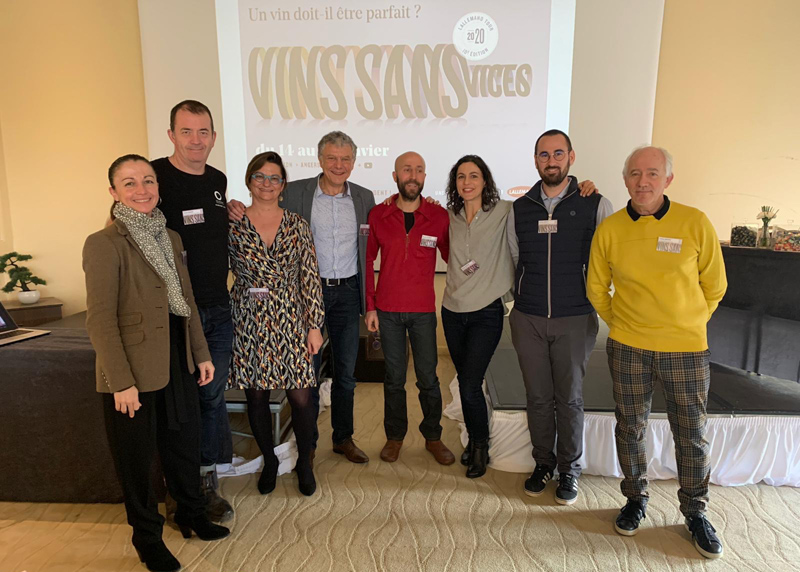
Interesting Alberto Antonini’s comment about Ru140 rootstock’s drought resistance in Sicily this year. I got to hate that rootstock so much in the Languedoc, that I tried to have it excluded from any new plantations when we were developing the rules for Gres de Montpellier. In the Languedoc, Ru140 is too vigourous and devours the soil’s water reserves often to grow excessive amounts of leaves that are then hedged off. It was the first rootstock to fail in INRA’s rootstock mother block during the 2003 heatwave. Moreover, it is hormonally out of sync with the vinifera. This means that when the vinifera wants to ripen grapes, Ru140 is still growing leaves. Consequently the grower has to wait, and wait, and wait for flavour developement resulting in very high sugars at harvest. I had a parcel of Grenache on 3309 next to a parcel of Grenache on Ru140, and the former ripened at 13% whereas the latter was still not as ripe at >15%.
But Ru140 was developed in Sicily, so maybe Mr Antonini is correct about it’s suitability in Sicily. And happily almost all the other major rootstocks were developed in the Languedoc (Richter as in 99R and 110R, was about 5kms from my vineyard), so there’s no excuse for using Ru140 in the Languedoc.
Thanks for the great blog.
Hello
First, thanks Jamie for your excellent blog and all of your wine info. One of the best!
I have offered (perhaps foolishly) to give a talk to my local wine group on ‘Climate Change and wine’.
As a geographer I am relatively OK with the climate change part – but which wines to use?
Initial ideas:
White Wines
1.An English Sparker
2.Chardonnay from Tasmania
3 & 4. Assyrtiko from Santorini and Jim Barry’s new Clare Valley Assyriko.
Red Wines.
1. Perhaps an English Pinot Noir, if I can find a good one!
2. Pinot Noir from Central Otago NZ
3. Perhaps a high altitude Malbec, Argentina.
Any ideas or suggestions most welcome !
Many Thanks
John Clark